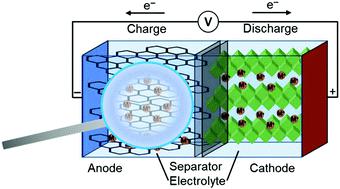当前位置:
X-MOL 学术
›
Energy Environ. Sci.
›
论文详情
Our official English website, www.x-mol.net, welcomes your feedback! (Note: you will need to create a separate account there.)
Electroanalytical methods and their hyphenated techniques for novel ion battery anode research
Energy & Environmental Science ( IF 32.5 ) Pub Date : 2020-07-10 , DOI: 10.1039/d0ee01184c Jianming Zhao 1, 2, 3, 4, 5 , Manuel Cano 6, 7, 8, 9, 10 , Juan J. Giner-Casares 6, 7, 8, 9, 10 , Rafael Luque 9, 10, 11, 12, 13 , Guobao Xu 1, 2, 3, 4, 5
Energy & Environmental Science ( IF 32.5 ) Pub Date : 2020-07-10 , DOI: 10.1039/d0ee01184c Jianming Zhao 1, 2, 3, 4, 5 , Manuel Cano 6, 7, 8, 9, 10 , Juan J. Giner-Casares 6, 7, 8, 9, 10 , Rafael Luque 9, 10, 11, 12, 13 , Guobao Xu 1, 2, 3, 4, 5
Affiliation

|
The physicochemical properties of the metal-ion battery anodes display a key role in the full behavior and electrochemical performance of energy storage devices. Novel ion battery anode materials (NIBAMs) are attracting a growing attention due to the capacity limitation of the classic graphite anodes, which provide low specific- and rate-capacity, and safety issues. Nevertheless, the electrochemical performance of NIBAMs such as the capacity, cyclability, rate capability, voltage profiles, and safety are strongly dependent on the structural and morphological evolution, phase transformation, ion diffusion, and electrode/electrolyte interface reconstruction during charge–discharge cycling and storage. In-depth understanding of the electrochemical process of NIBAMs is essential for optimizing their preparation and application conditions, and exploring NIBAMs. Traditional electroanalytical methods, such as charge/discharge, cyclic voltammetry, and electrochemical impedance spectroscopy are utilized to research the capacity, resistance, rate capability and cyclability of NIBAMs. Recently, rapid progress and development in hyphenated techniques by coupling with X-ray, electron, scanning probe, optics, neutron, and magnetic techniques have provided extensive insights into the nature of structural evolution and morphological changes of NIBAMs, and electrode/electrolyte interface. In this review, a comprehensive overview of both classical electroanalytical methods and advanced electroanalytical hyphenated techniques for studying the NIBAMs is provided.
中文翻译:

电分析方法及其联用技术在新型离子电池负极研究中的应用
金属离子电池阳极的物理化学性质在储能装置的全部性能和电化学性能中显示出关键作用。由于经典石墨阳极的容量限制,新型离子电池阳极材料(NIBAM)引起了越来越多的关注,这种石墨阳极具有较低的比容量和倍率容量以及安全性问题。然而,NIBAM的电化学性能,例如容量,循环能力,速率能力,电压分布和安全性,在很大程度上取决于结构在放电过程中的结构和形态演变,相变,离子扩散以及电极/电解质界面的重建。存储。深入了解NIBAM的电化学过程对于优化其制备和应用条件至关重要,和探索NIBAM。传统的电分析方法,例如充电/放电,循环伏安法和电化学阻抗谱法,被用于研究NIBAM的容量,电阻,速率能力和可循环性。近来,通过与X射线,电子,扫描探针,光学,中子和磁性技术相结合,断字技术的快速进步和发展为NIBAMs的结构演化和形态变化以及电极/电解质界面的性质提供了广泛的见识。在这篇综述中,提供了用于研究NIBAM的经典电分析方法和高级电分析联用技术的全面概述。利用电化学阻抗谱技术研究了NIBAM的容量,电阻,速率能力和循环能力。近来,通过与X射线,电子,扫描探针,光学,中子和磁性技术相结合,断字技术的快速进步和发展为NIBAMs的结构演化和形态变化以及电极/电解质界面的性质提供了广泛的见识。在这篇综述中,提供了用于研究NIBAM的经典电分析方法和高级电分析联用技术的全面概述。利用电化学阻抗谱技术研究了NIBAM的容量,电阻,速率能力和循环能力。近来,通过与X射线,电子,扫描探针,光学,中子和磁性技术相结合,断字技术的快速进步和发展为NIBAMs的结构演化和形态变化以及电极/电解质界面的性质提供了广泛的见识。在这篇综述中,提供了用于研究NIBAM的经典电分析方法和高级电分析联用技术的全面概述。磁技术已经为NIBAM的结构演化和形态变化的性质以及电极/电解质界面提供了广泛的见识。在这篇综述中,提供了用于研究NIBAM的经典电分析方法和高级电分析联用技术的全面概述。磁技术已经为NIBAM的结构演化和形态变化的性质以及电极/电解质界面提供了广泛的见识。在这篇综述中,提供了用于研究NIBAM的经典电分析方法和高级电分析联用技术的全面概述。
更新日期:2020-09-16
中文翻译:

电分析方法及其联用技术在新型离子电池负极研究中的应用
金属离子电池阳极的物理化学性质在储能装置的全部性能和电化学性能中显示出关键作用。由于经典石墨阳极的容量限制,新型离子电池阳极材料(NIBAM)引起了越来越多的关注,这种石墨阳极具有较低的比容量和倍率容量以及安全性问题。然而,NIBAM的电化学性能,例如容量,循环能力,速率能力,电压分布和安全性,在很大程度上取决于结构在放电过程中的结构和形态演变,相变,离子扩散以及电极/电解质界面的重建。存储。深入了解NIBAM的电化学过程对于优化其制备和应用条件至关重要,和探索NIBAM。传统的电分析方法,例如充电/放电,循环伏安法和电化学阻抗谱法,被用于研究NIBAM的容量,电阻,速率能力和可循环性。近来,通过与X射线,电子,扫描探针,光学,中子和磁性技术相结合,断字技术的快速进步和发展为NIBAMs的结构演化和形态变化以及电极/电解质界面的性质提供了广泛的见识。在这篇综述中,提供了用于研究NIBAM的经典电分析方法和高级电分析联用技术的全面概述。利用电化学阻抗谱技术研究了NIBAM的容量,电阻,速率能力和循环能力。近来,通过与X射线,电子,扫描探针,光学,中子和磁性技术相结合,断字技术的快速进步和发展为NIBAMs的结构演化和形态变化以及电极/电解质界面的性质提供了广泛的见识。在这篇综述中,提供了用于研究NIBAM的经典电分析方法和高级电分析联用技术的全面概述。利用电化学阻抗谱技术研究了NIBAM的容量,电阻,速率能力和循环能力。近来,通过与X射线,电子,扫描探针,光学,中子和磁性技术相结合,断字技术的快速进步和发展为NIBAMs的结构演化和形态变化以及电极/电解质界面的性质提供了广泛的见识。在这篇综述中,提供了用于研究NIBAM的经典电分析方法和高级电分析联用技术的全面概述。磁技术已经为NIBAM的结构演化和形态变化的性质以及电极/电解质界面提供了广泛的见识。在这篇综述中,提供了用于研究NIBAM的经典电分析方法和高级电分析联用技术的全面概述。磁技术已经为NIBAM的结构演化和形态变化的性质以及电极/电解质界面提供了广泛的见识。在这篇综述中,提供了用于研究NIBAM的经典电分析方法和高级电分析联用技术的全面概述。



























 京公网安备 11010802027423号
京公网安备 11010802027423号